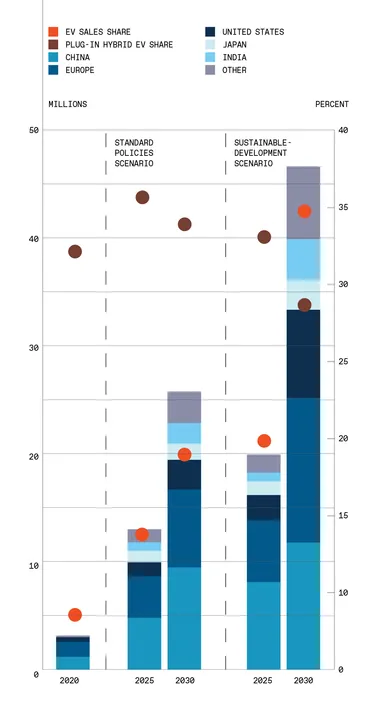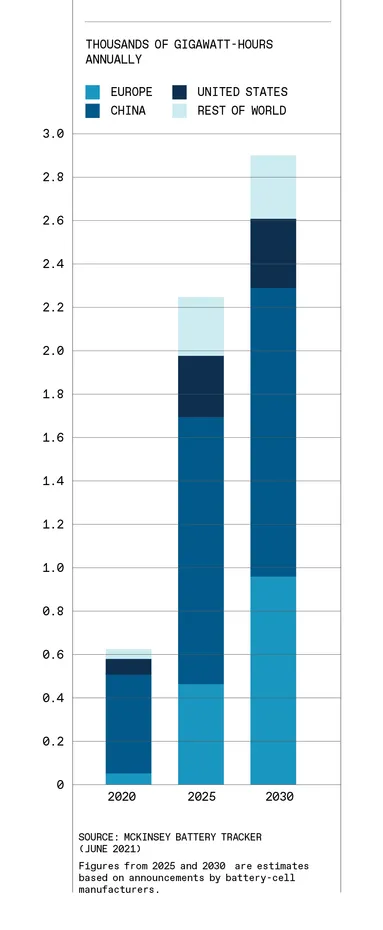THE EV TRANSITION IS HARDER THAN ANYONE THINKS
Clueless policymakers, skeptical consumers, greedy automakers—and the tech isn’t ready either
VOLVO CARS CEO JIM ROWAN boldly proclaims that electric vehicles will reach price parity with internal-combustion-engine (ICE) vehicles by 2025. Not likely, counter Mercedes-Benz’s chief technology officer Markus Schäfer and Renault Group CEO Luca de Meo.
The International Energy Agencypredicts that EVs will make up more than 60 percent of vehicles sold globally by 2030. But given the sheer tonnage of lithium, cobalt, and other raw materials needed for EV batteries, that figure is overly optimistic, suggests the mineral market analysis company Benchmark Mineral Intelligence, unless nearly 300 new mines and supporting refineries open by then.
EV owners should be urged to charge at night to save not only money and the power grid but “ the world,” a news headline cries out. Not so fast, exclaim researchers at Stanford University, who state that charging EVs during the day is actually cheaper, better for the grid, and healthier for the environment.
And so goes the litany of contradictory statements about the transition to EVs:
- EVs will/will not collapse the electric grid.
- EVs will/will not cause massive unemployment among autoworkers.
- EVs will/will not create more pollution than they eliminate.
Confused? Join the crowd.
Sorting through this contradictory rhetoric can make anyone’s head spin. My response to each proclamation is often a shrug followed by “It depends.”
Two years ago, I began investigating the veracity of claims surrounding the transition to EVs at scale. The result is a 12-part series and e-book, The EV Transition Explained, that explores the tightly woven technological, policy, and social issues involved. The articles are based on scores of interviews I conducted with managers and engineers in the auto and energy industries, as well as policy experts, academic researchers, market analysts, historians, and EV owners. I also reviewed hundreds of reports, case studies, and books surrounding EVs and electrical grids.

What I found is an intricately tangled web of technological innovation, complexity, and uncertainty, combined with equal amounts of policy optimism and dysfunction. These last two rest on rosy expectations that the public will quietly acquiesce to the considerable disruptions that will inevitably occur in the coming years and decades. The transition to EVs is going to be messier, more expensive, and take far longer than the policymakers who are pushing it believe.
Scaling is hard
Let me be very clear: Transitioning to electric vehicles and renewable energy to combat climate change are valid goals in themselves. Drastically reducing our fossil-fuel use is key to realizing those goals. However, attempting to make such transitions at scale in such a short period is fraught with problems, risks, and unanticipated consequences that need honest and open recognition so they can be actively and realistically addressed. Going to scale means not only manufacturing millions of EVs per year but supporting them from recharging to repair.
A massive effort will be needed to make this happen. For example, in January 2023 the sales of EVs in the United States reached 7.83 percent of new light-duty vehicle sales, with 66,416 battery-electric vehicles (BEVs) and 14,143 plug-in hybrid vehicles (PHEVs) sold. But consider that also in January, some 950,000 new ICE light-duty vehicles were sold, as well as approximately another 3 million used ICE vehicles.
Government policymakers assume that they can incentivize the supply and demand of EVs while paying relatively less attention to the capacity of global supply chains to produce them, along with the energy conversion complex needed to power them. Shifting the auto industry, an apex industry supporting a host of others to meet a new knowledge economy around EVs will be no easy task.
MATTHEW EISLER, lecturer at the University of Strathclyde
Transforming the energy and transportation sectors simultaneously will involve a huge number of known and unknown variables, which will subtly interact in complex, unpredictable ways. As EVs and renewable energy scale up, the problems and the solutions will cover ever-expanding populations and geographies. Each proposed solution will probably createnew difficulties. In addition, going to scale threatens people’s long-held beliefs, ways of life, and livelihoods, many of which will be altered, if not made obsolete. Technological change is hard, social change even harder.
And yet, the rush to transition to EVs is logical. Parts of the world are already experiencing climate-change-related catastrophes, and governments around the world have pledged to act under the Paris Agreement to limit global temperature rise to 1.5 °C above preindustrial levels. This agreement requires the reduction of greenhouse gases across all industrial sectors. Transportation is one of the largest contributors of GHG emissions worldwide, and many experts view replacing ICE vehicles with EVs as being the quickest and easiest way to reach the target of net-zero carbon emissions by 2050.
However, shifting a 125-year-old auto industry that’s optimized for ICE-vehicle production to EVs using nascent technology is a monumental challenge in itself. Requiring that automakers do so in 15 years or less is even more daunting, although part of it is their own doing by not recognizing earlier thatEVs might be a threat to their business models. EVs require automakers and their suppliers to reinvent their supply chains, hire employees with new software, battery, and mechatronic skill sets, and retrain or else lay off workers whose outdated skills are no longer needed.
The articles in the series address different aspects of this transition, including EV-related unemployment, battery issues, the EV charging infrastructure, and affordability. One not entirely surprising finding is that the traditional automakers are electrifying their offerings while also squeezing the last bit of profit from their gas guzzlers. That is, they are introducing less-expensive EV models, but their main thrust is still on producing profitable luxury EV models that are well beyond the means of the average household while also pushing sales of profitable fossil-fuel-powered SUVs.
EVs are not just a technology change
Electric vehicles are more than just a new technology for combating climate change. In the United States, for instance, policymakers view EVs as the tip of the spear for a vast program of government-directed economic nationalism—the economic, environmental, and societal change aimed at completely reshaping the nation’s US $26 trillion economy away from fossil fuels. They see normal market forces as inadequate to meet the imposed climate deadlines. Hence, with the Biden administration’s encouragement, ICE-vehicle sales will be banned in 2035 in California and several other states. In the series, I scrutinize several such EV policies and take a look at the roadblocks that could derail them, such as inadequately sized pole transformers and the failure to issue permits for new electricity transmission lines.

The United States is not alone in seeing EVs as an economic driver, of course. Worldwide, nearly 60 countries are now imposing similar ICE-vehicle sales bans. This has forced EVs into yet another role: as a cudgel to be wielded in the fierce geopolitical competition for economic advantage. For China, Japan, the United Kingdom, the European Union, and the United States, EVs are the vehicle needed to “win the future of transportation and manufacturing.” Consider the reactions to the recent change in U.S. EV subsidy policy, which aims to boost domestic EV manufacturing and energy security. The decision deeply angered other countries and is sparking moves to counter it.
EVs alone aren’t sufficient to meet carbon-reduction targets, which means enormous lifestyle changes for many of us, as we try to do our part to combat climate change. People will need to drive and fly less, walk and bike more, and take public transportation. We’ll need to switch to a more plant-based diet and convert household appliances powered by fossil fuels to electricity, to name only a few looming adjustments. People’s willingness to accept these changes and their ability to implement them will be crucial to our success at adapting to climate change and mitigating its impacts.
The introduction of any new system spawns perturbations that create surprises, both wanted and unwanted. We can safely assume that quickly moving to EVs at scale will unleash its fair share of unpleasant surprises, as well as prove the adage of “haste makes waste.”
Take a systems-engineering approach
What struck me most in writing the series was that the EV transition is incredibly fluid. Major changes in transportation and energy policy, battery technology, and automakers’ strategies are announced nearly daily, highlighting the many uncertainties. Given the geopolitical nature of the transition, these uncertainties will only increase.
These rapid changes also show the fragility of the transition. The desperate pleas from automakers for more government subsidies is not reassuring. Tesla’s recent price cuts, for instance, have thrown the auto industry into turmoil. Neither is a sign of a market that is sure of itself or its future.
This fragility is also obvious when you examine the overly optimistic assumptions and the many caveats buried in EV and energy-policy recommendations. Many things need to go exactly right, and very little can go wrong for the EV transition to transpire as planned. At times like these, I’m reminded of Nobel Prize–winning physicist Richard Feynman’s admonishment: “For a successful technology, reality must take precedence over public relations, for Nature cannot be fooled.”
There is a cacophony of foolishness being spouted by those advocating for the EV transition and by those denouncing it. It is time for the nonsense to stop, and some realistic political and systems thinking to begin.
Read the full article at the original website.
References:
-
https://www.roadandtrack.com/news/a39627829/when-will-evs-be-cheaper/
-
https://news.stanford.edu/press-releases/2022/09/22/charging-cars-honight-not-way-go/
-
https://spectrum.ieee.org/the-ev-transition-explained-2659602311/particle-4
-
https://spectrum.ieee.org/the-ev-transition-explained-2659602311/particle-8
-
https://spectrum.ieee.org/the-ev-transition-explained-2658797703
-
https://spectrum.ieee.org/the-ev-transition-explained-2659602311/particle-12
-
https://spectrum.ieee.org/the-ev-transition-explained-2659602311/particle-13
-
https://spectrum.ieee.org/the-ev-transition-explained-2659602311/battery-cell-production-capacity
-
https://spectrum.ieee.org/the-ev-transition-explained-2659602311/particle-6
-
https://spectrum.ieee.org/the-ev-transition-explained-2659602311/particle-7
-
https://spectrum.ieee.org/the-ev-transition-explained-2659602311/particle-5
-
https://insideevs.com/news/632699/tesla-massive-price-cuts-shocks-auto-industry/
-
https://www.iea.org/reports/global-ev-outlook-2021/policies-to-promote-electric-vehicle-deployment
